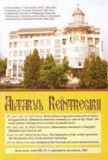Raporturile oficiale între patriarhi în primele secole. Problema întâietăţii de onoare în cadrul
Pentarhiei
Official Relationships between the Patriarchs. The Issue of Primacy within the Pentarchy
Author(s): Marius TeleaSubject(s): Christian Theology and Religion, History of Church(es), Theology and Religion
Published by: Facultatea de Teologie Ortodoxă Alba Iulia
Keywords: Bishop of Rome;Patriarchy of Constantinople;Pentarchy;Primacy;Bishops;Roman Emperors;
Summary/Abstract: From ancient times, the hierarchs who had their sees in Rome, Alexandria and Antioch had a higher authority in the Christian world because these sees were of apostolic origin. The Bishop of Rome, the capital of the Roman Empire, was considered to have the highest authority (later on, he was even attributed the quality of successor of the Apostle Peter). However, when Constantinople was founded, the Bishop of Byzantion (city that was Christianized only after the 2nd century AD) was only a suffragan of the Metropolitan of Heraclea from Pontus and his name did not appear on the lists of the participants in the First Nicaea Council (325 AD). In terms of authority and power, the Patriarchy of Constantinople was subordinated to the imperial institution. Its importance did not only come from the part it had played throughout the history of the Empire, but also from the fact that it survived after the fall of the Empire as the continuator in time and space of the Byzantine civilization. Considering that the Eastern Roman Empire lasted almost a thousand years more than the Western one and that its element of osmosis and preservation was the Christian faith, we can see the reason why this Patriarchy had such a high importance in the Byzantine history, culture, and civilization. Over the years, because of the changes that appeared in the Empire and of the increasing influence of the political factor, Constantinople – the new Byzantine capital – was no longer anonymous and came to hold the second place in the hierarchy of the Bishops’ see and the first one within the Eastern Church. The ascension of the capital was possible in an environment of prolonged discussions and numerous conflicts that lasted until the 11th century.
Journal: Altarul Reîntregirii
- Issue Year: XIX/2014
- Issue No: 1
- Page Range: 183-209
- Page Count: 27
- Language: Romanian

